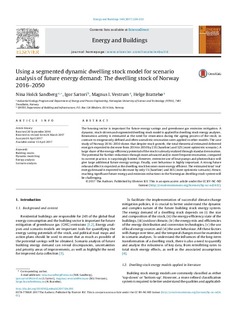| dc.contributor.author | Sandberg, Nina Holck | |
| dc.contributor.author | Sartori, Igor | |
| dc.contributor.author | Vestrum, Magnus Inderberg | |
| dc.contributor.author | Brattebø, Helge | |
| dc.date.accessioned | 2017-07-06T11:07:04Z | |
| dc.date.available | 2017-07-06T11:07:04Z | |
| dc.date.created | 2017-04-18T10:06:48Z | |
| dc.date.issued | 2017 | |
| dc.identifier.citation | Energy and Buildings. 2017, 146 220-232. | nb_NO |
| dc.identifier.issn | 0378-7788 | |
| dc.identifier.uri | http://hdl.handle.net/11250/2448057 | |
| dc.description.abstract | The housing sector is important for future energy savings and greenhouse gas emission mitigation. Adynamic, stock-driven and segmented dwelling stock model is applied for dwelling stock energy analyses.Renovation activity is estimated as the need for renovation during the ageing process of the stock, incontrast to exogenously defined and often unrealistic renovation rates applied in other models. The casestudy of Norway 2016–2050 shows that despite stock growth, the total theoretical estimated deliveredenergy is expected to decrease from 2016 to 2050 by 23% (baseline) and 52% (most optimistic scenario). Alarge share of the energy-efficiency potential of the stock is already realized through standard renovation.The potential for further reductions through more advanced and/or more frequent renovation, comparedto current practice, is surprisingly limited. However, extensive use of heat pumps and photovoltaics willgive large additional future energy savings. Finally, user behaviour is highly important. A strong futurerebound effect is expected as the dwelling stock becomes more energy efficient. The estimated total ‘real’energy demand is expected to decrease by only 1% (baseline) and 36% (most optimistic scenario). Hence,reaching significant future energy and emission reductions in the Norwegian dwelling stock system willbe challenging. | nb_NO |
| dc.language.iso | eng | nb_NO |
| dc.publisher | Elsevier Ltd. | nb_NO |
| dc.rights | Attribution-NonCommercial-NoDerivatives 4.0 Internasjonal | * |
| dc.rights.uri | http://creativecommons.org/licenses/by-nc-nd/4.0/deed.no | * |
| dc.subject | Building stock | nb_NO |
| dc.subject | Dynamic modelling | nb_NO |
| dc.subject | Energy analysis | nb_NO |
| dc.subject | Scenario analysis | nb_NO |
| dc.title | Using a segmented dynamic dwelling stock model for scenario analysis of future energy demand: The dwelling stock of Norway 2016–2050 | nb_NO |
| dc.type | Journal article | nb_NO |
| dc.type | Peer reviewed | nb_NO |
| dc.description.version | publishedVersion | nb_NO |
| dc.rights.holder | © 2017 The Authors.This is an open access article under the CC BY-NC-NDlicense (http://creativecommons.org/licenses/by-nc-nd/4.0/). | nb_NO |
| dc.subject.nsi | VDP::Technology: 500 | nb_NO |
| dc.source.pagenumber | 220-232 | nb_NO |
| dc.source.volume | 146 | nb_NO |
| dc.source.journal | Energy and Buildings | nb_NO |
| dc.identifier.doi | 10.1016/j.enbuild.2017.04.016 | |
| dc.identifier.cristin | 1465214 | |
| cristin.unitcode | 7401,30,20,0 | |
| cristin.unitname | Bygninger og installasjoner | |
| cristin.ispublished | true | |
| cristin.fulltext | original | |
| cristin.qualitycode | 2 | |

